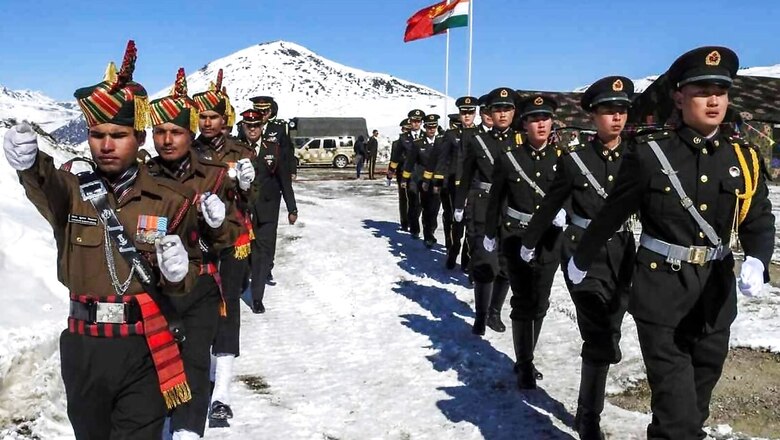
views
The relationship between India and China has been a saga of distrust, betrayal and missed opportunities. Nehru’s India was among the first nations to recognize communist China in 1949. It pushed China for permanent membership of the UN Security Council. Yet, China reciprocated India’s goodness by backstabbing, as it attacked India in 1962 and continues to hold large tracts of Indian territory to date. The effort in the intervening years apparently gave an impression of China adopting the option of peace and tranquility, as it signed a number of agreements with India for peaceful co-existence as well as for resolving the border and Line of Actual Control (LAC) disputes. While India saw this from a positive prism, China was working hard to create capacities in multiple domains in the intervening period so that it could strike again as India was rising with unprecedented speed in Asia and the world.
While the world thought that Taiwan will remain China’s primary concern for its plan of unification and India still has substantial numbers of years for capacity creation, all this is not turning out to be true if the current events/indicators are objectively analysed. Taiwan controls close to 50 percent of the semiconductor industry in the world and even China is dependent on Taiwan for its supply. Not only this, in case of a physical attack by China on Taiwan, the United States, South Korea and Japan are likely to join the battle and therefore, China may not be keen on a direct confrontation with Taiwan at the moment. It is, therefore, obvious that China has selected India to tie down the country’s growth as it can control the escalation of LAC conflicts to a large extent.
When Indian strategists were probably thinking that China will focus more on Tawang or other areas of Arunachal Pradesh for conflict escalation, as it is already occupying a majority of Indian areas of Aksai Chin, it did exactly the opposite. It made large-scale intrusions at multiple points across LAC in eastern Ladakh which came to be known somewhere in April 2020. As this was not enough, it orchestrated the Galwan clash on 5 May 2020, where unarmed soldiers were attacked by high-end lethal weapons which resulted in the death of a commanding officer and 19 soldiers of different ranks. As for the exact casualties on the Chinese side, it is yet to be revealed. The Galwan clash was a clear defiance of all the bilateral agreements and against human value systems. The trust between the forces nosedived, which was also reflected in diplomatic engagements and political relationships.
Though the entire government approach post-Galwan clash is not known except what has come in the open domain, the showcasing of Chinese soldiers in the Beijing Olympics should have been noted with more seriousness as it reflected that the entire incursion on LAC in eastern Ladakh, as well as the methodology adopted in the Galwan clash, was not a local action but had the approval of the highest hierarchy in China.
It was, therefore, prudent on our part to re-calibrate our strategy. A number of actions have been taken and more are probably in offing whether it’s infrastructure push or capacity creation in the defence forces, including indigenisation. The nosedived trust deficit in Galwan had probably prepared the Indian forces well for Yangtse-like actions which happened on 9 December 2022, but got reported in the open domain as late as 12 December 2022. The gaps in information which occurred after the intrusion in eastern Ladakh after the Galwan clash and now after the Yangtse clash, need to be looked at seriously, as such gaps fill the information space with adversaries’ narratives at times. Prompt and correct action should be the need of the hour. The heroic deed of our gallant soldiers in repulsing Chinese actions needs to be known to the countrymen.
The exact mechanics of the Yangtse clash is not important. The important facet in the size of the force reported from 300 to 600 cannot be termed as a patrol size force as it’s almost close to battalion strength. Open domain information also indicates that this People’s Liberation Army (PLA) force was equipped on similar lines which attacked unarmed Indian soldiers in Galwan. What is needed is the acceptance at all forums that China can never be trusted and all agreements/political directions are null and void for a country like China.
Nosediving of trust from Galwan to Yangtse has completed a full circle and India needs to strengthen its security apparatus all along the LAC. The infrastructure push must be ensured so that we are able to put our troops at every vulnerable location of our border, even if it involves substantial costs which can be reduced by utilising modern surveillance means. In any case, there is no equivalent cost of national security. The nation survives only with its sovereign profile. Our policies must be re-visited in all the domains in an era of nosedived trust status from China. The earlier it is done, the better.
The writer is a retired Army veteran. Views expressed are personal.
Read all the Latest Opinions here


















Comments
0 comment